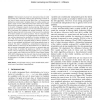Free Online Productivity Tools
i2Speak
i2Symbol
i2OCR
iTex2Img
iWeb2Print
iWeb2Shot
i2Type
iPdf2Split
iPdf2Merge
i2Bopomofo
i2Arabic
i2Style
i2Image
i2PDF
iLatex2Rtf
Sci2ools
PAMI
2011
2011
Greedy Learning of Binary Latent Trees
—Inferring latent structures from observations helps to model and possibly also understand underlying data generating processes. A rich class of latent structures are the latent trees, i.e. tree-structured distributions involving latent variables where the visible variables are leaves. These are also called hierarchical latent class (HLC) models. Zhang (2004) proposed a search algorithm for learning such models in the spirit of Bayesian network structure learning. While such an approach can find good solutions it can be computationally expensive. As an alternative we investigate two greedy procedures: the BIN-G algorithm determines both the structure of the tree and the cardinality of the latent variables in a bottom-up fashion. The BIN-A algorithm first determines the tree structure using agglomerative hierarchical clustering, and then determines the cardinality of the latent variables as for BIN-G. We show that even with restricting ourselves to binary trees we obtain HLC models ...
Hierarchical Latent Class | Interpretable Latent Structures | Latent Structures | Operations Research | PAMI 2011 |
| Added | 14 May 2011 |
| Updated | 14 May 2011 |
| Type | Journal |
| Year | 2011 |
| Where | PAMI |
| Authors | Stefan Harmeling, Christopher K. I. Williams |
Comments (0)

